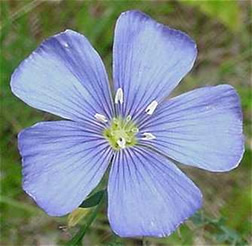This page has been archived and is being provided for reference purposes only. The page is no longer being updated, and therefore, links on the page may be invalid.
Read the magazine story to find out more. |
|
Flax Fiber Has New International Standards
By Sharon DurhamAugust 15, 2005
New international quality standards for flax fiber have been established, thanks to Agricultural Research Service (ARS) scientists. Standards have been established for fineness, color and cleanliness of the fiber.
The standards help assure uniform quality and performance, according to microbiologist Danny E. Akin in the ARS Quality Assessment Research Unit at Athens, Ga. Natural fibers such as flax/linen are variable, so standards are particularly useful for manufacturers of textiles and composites. Without standards, manufacturers lack the knowledge of how to set equipment for optimal production.
Flax fiber went out of vogue in the United States with the introduction of the cotton gin, which vaulted cotton into popularity.
In the United States, flax is now grown for seed--linseed, for example--mostly in North Dakota. A market for flax fiber has been difficult to establish, partly because there have been no standards in place to govern its quality. That is being changed.
Akin chairs the ASTM International Subcommittee "Flax and Linen," which is responsible for establishing standards for flax fibers. Four standards have been developed to date, including terminology, color measurement, fineness and cleanliness. ASTM, originally known as the American Society for Testing and Materials, was formed more than a century ago and is one of the largest voluntary standards-development organizations in the world.
These standards set the stage for an expansion of manufacturing use of flax products into lighter, more environmentally friendly composites that can be used to replace glass in cars. Some major car manufacturers have expressed interest in such a product. Flax products could also find use in the medical arena as bandages, and short flax fibers can be blended with cotton or other fibers for specialty products.
Read more about the research in the August 2005 issue of Agricultural Research magazine.
ARS is the U.S. Department of Agriculture's chief in-house scientific research agency.


